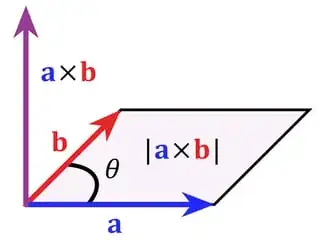For example, $F = I \times B$. Why would the force be perpendicular to both the magnetic field and the current? Why would the resultant force be totally unlike its 2 sources; this could be likened to someone moving in a straight line, a force pushing the person to the left and suddenly the person flies up???
3 Answers
Why is the result perpendicular to both operands? The answer is that the cross product is not the best math object to use to describe these things.
The better object is the bivector, which is an object that specifies a directed area rather than a directed line segment. No more vector at right angles to both operands. Instead, two vector specify an area object. It is an element of geometrical algebra (a realization of Clifford algebra) which contains many more things such as vectors, complex numbers, spinors and quaternions.
Because that algebra unifies many objects in any number of dimensions, it appears to be the more natural mathematical description than ordinary Gibbs-Heaviside vector analysis. In three dimensions (and only in three dimensions) a bivector maps one-to-one with a cross product, so either can be used, but in vector analysis you end up with oddities such as the resultant vector sticking out at right angles to the operands, and the existence of two types of vectors: polar and axial. On the other hand, conventional vector analysis has fewer objects and operations, and is "closed" in the sense that vector operations produce only other vectors. Consequently, and importantly for students, conventional vector analysis is easier to learn.
Another perfectly good answer to your question: the cross product produces a vector derived from two other vectors. How to specify a direction associated with two vectors? The direction perpendicular to both. The sign is chosen by convention to be given by the right hand rule. It seems remarkable to me that this works, but it does if you are willing to suffer the existence of polar and axial vectors.
- 22,633
The cross product is exactly the mathematical function that expresses what happens to a current-carrying conductor in an external magnetic field.
The direction and strength of an electric current can be represented by a vector, where the current strength determines the length of the vector. The direction and strength of the acting magnetic field is also presented by a vector.
Empirically, i.e. through experiments, it is known that the current conductor (if it is suspended in a movable manner) is deflected laterally. In concrete terms, sideways means that the conductor is deflected perpendicular to the surface formed by the two vectors.
In concrete terms, two special cases can be highlighted.
- the direction of the current and the magnetic field are the same (parallel or anti-parallel). Then the spanned area between the two vectors is zero. This corresponds to the experiment; the current conductor is not deflected.
- The directions of current and magnetic field are at 90° (perpendicular) to each other. The area between the two vectors is at a maximum. This corresponds to the experimental result; the current conductor is deflected with maximum force.
Another special feature of the cross product is the right hand rule. If the first vector (the current I) is represented by the thumb and the second vector (the magnetic field) by the index finger, then the middle finger indicates the direction of movement of the conductor. So here, too, the experiment is correctly represented by the mathematical function of the cross product.
Why is the cross product used in electrodynamics? Because this mathematical function corresponds exactly to what the experiment shows.
- 10,980
In this case the force is a measure of how strong the current is in the directions perpendicular to the magnetic field
$$ \| \boldsymbol{i}_{\perp} \| = \frac{ \| \boldsymbol{F} \| }{\| \boldsymbol{B} \|} $$
If the measured force was zero, the entirety of the current flow is parallel to the magnetic field, and $\boldsymbol{i}_{\perp} = 0$
So the measurement of force gives you an idea of the current flow in relation to the magnetic field direction.
That is literally all there is to it. If there is a force present, then some current must be flowing in a direction perpendicular to the magnetic field, or the dual of there is a component of the magnetic field that is perpendicular to the current.
Here is the mathematical treatment of the above statement:
Consider a current flow only perpendicular to the magnetic field
$$ \boldsymbol{F}=\boldsymbol{i}_{\perp}\times\boldsymbol{B} $$
and take the cross product with the magnetic field on both sides (and apply the vector triple product identity) to get
$$ \require{cancel} \boldsymbol{B}\times\boldsymbol{F}=\boldsymbol{B}\times\left(\boldsymbol{i}_{\perp}\times\boldsymbol{B}\right)=\boldsymbol{i}_{\perp}\left(\boldsymbol{B}\cdot\boldsymbol{B}\right)-\boldsymbol{B}\left(\cancel{\boldsymbol{i}_{\perp}\cdot\boldsymbol{B}}\right)$$
Solve for the current above and simplify
$$ \boldsymbol{i}_{\perp}=\frac{\boldsymbol{B}\times\boldsymbol{F}}{\boldsymbol{B}\cdot\boldsymbol{B}}$$
and $$\|\boldsymbol{i}_{\perp} \| =\frac{\|\boldsymbol{B}\|\,\|\boldsymbol{F}\|\cancelto{1}{\sin\theta}}{\|\boldsymbol{B}\|^{2}}=\frac{\|\boldsymbol{F}\|}{\|\boldsymbol{B}\|} $$
- 40,139
